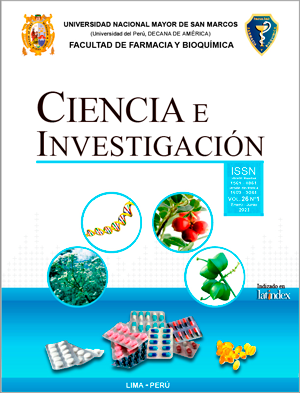Biomonitoring of ethanol: retrospective alcoholemia analysis based on two successive blood samples
DOI:
https://doi.org/10.15381/ci.v26i1.27482Keywords:
retrospective blood alcohol, biomonitoring, gas chromatography, two blood samples, ethanolAbstract
Ethanol use and abuse is frequently associated with medical-legal implications and consequences. The objective of this study was to evaluate retrospective blood alcohol levels based on two successive blood samples from people who had post-ingestion of alcoholic beverages. Ethanol as beer was administered as a single dose 0.8 g/kg to subjects in group I, sufficient blood samples were collected and the concentration-time profile of ethanol was designed and toxicokinetic parameters were determined; groups II and III released beer ad libitum and two blood samples were drawn at different time intervals. The ethanol was quantified by gas chromatography. Backward extrapolations of blood alcohol levels were estimated assuming zero-order kinetics and elimination rate range 0.10 to 0.35 g/L/h. In group I, the volume of distribution 0.70 L/kg, maximum BAC 1.05 g/L at 60 min and average elimination rate 0.148 g/L/h were determined. It was shown that only in group III were the averages of ethanol concentrations in the second blood sample lower than the first, signifying elimination phase, and the retrospective BAC data with upper and lower limits were accurate, feasible and valid. In conclusion, the BAC levels of a person obtained in two blood samples 30 to 45 min apart, the first one taken immediately after the punishable event and the second one during the elimination phase, allow the estimation of the upper and lower limits of retrospective BAC with precision and high reliability compared to the traditional study of BAC with only one blood sample.
Downloads
Published
Issue
Section
License
Copyright (c) 2023 Luis A. Inostroza, Américo J. Castro, Amadeo Collado, Elder M. Reyes, Luis A. Velarde

This work is licensed under a Creative Commons Attribution 4.0 International License.
LOS AUTORES RETIENEN SUS DERECHOS:
- Los autores retienen sus derechos de marca y patente, y tambien sobre cualquier proceso o procedimiento descrito en el artículo.
- Los autores retienen el derecho de compartir, copiar, distribuir, ejecutar y comunicar públicamente el articulo publicado en la Revista Ciencia e Investigación (por ejemplo, colocarlo en un repositorio institucional o publicarlo en un libro), con un reconocimiento de su publicación inicial en la Revista Ciencia e Investigación.
- Los autores retienen el derecho a hacer una posterior publicación de su trabajo, de utilizar el artículo o cualquier parte de aquel (por ejemplo: una compilación de sus trabajos, notas para conferencias, tesis, o para un libro), siempre que indiquen la fuente de publicación (autores del trabajo, revista, volumen, numero y fecha).













